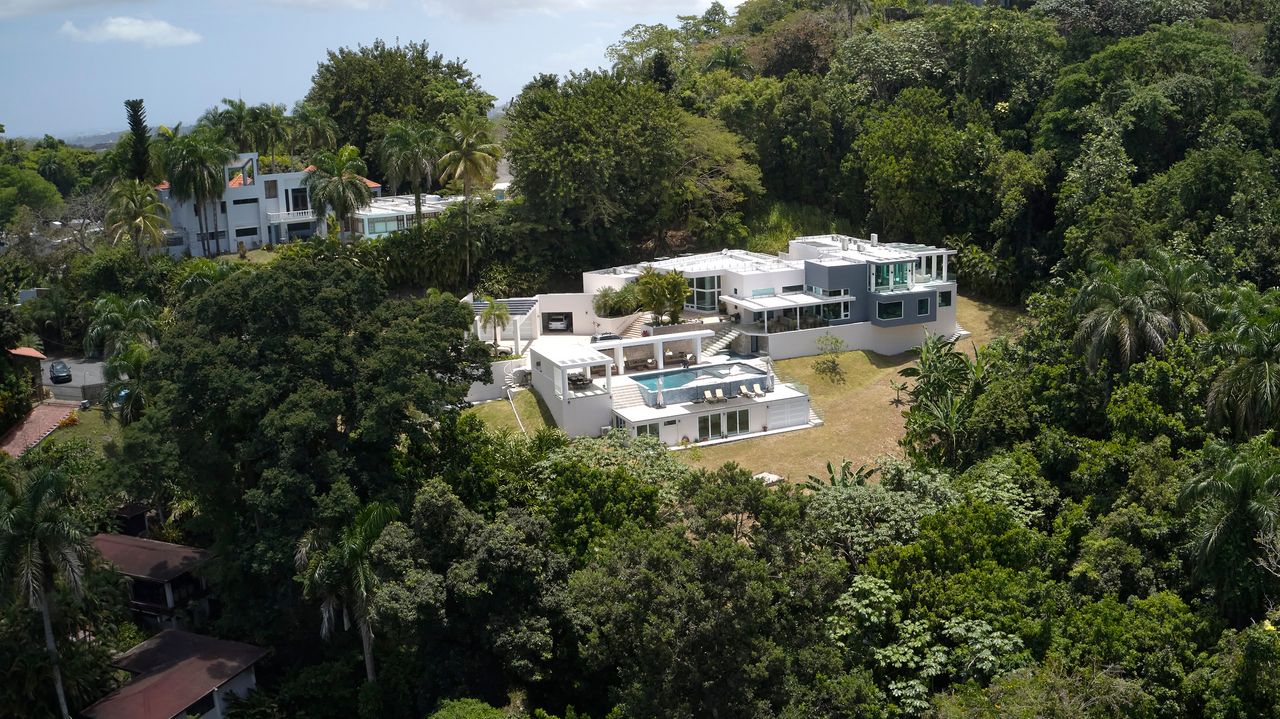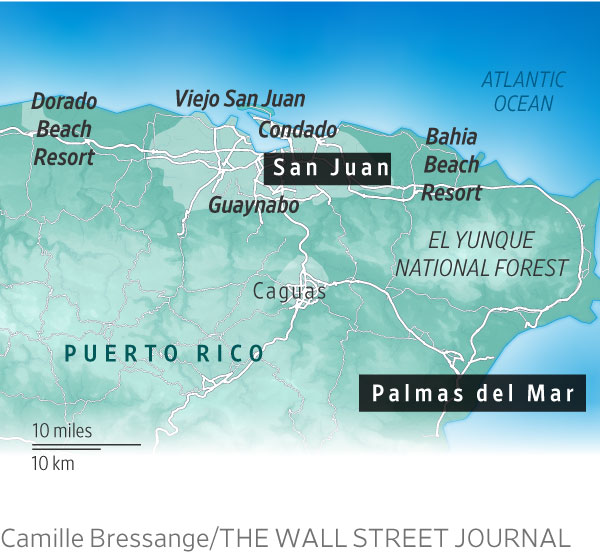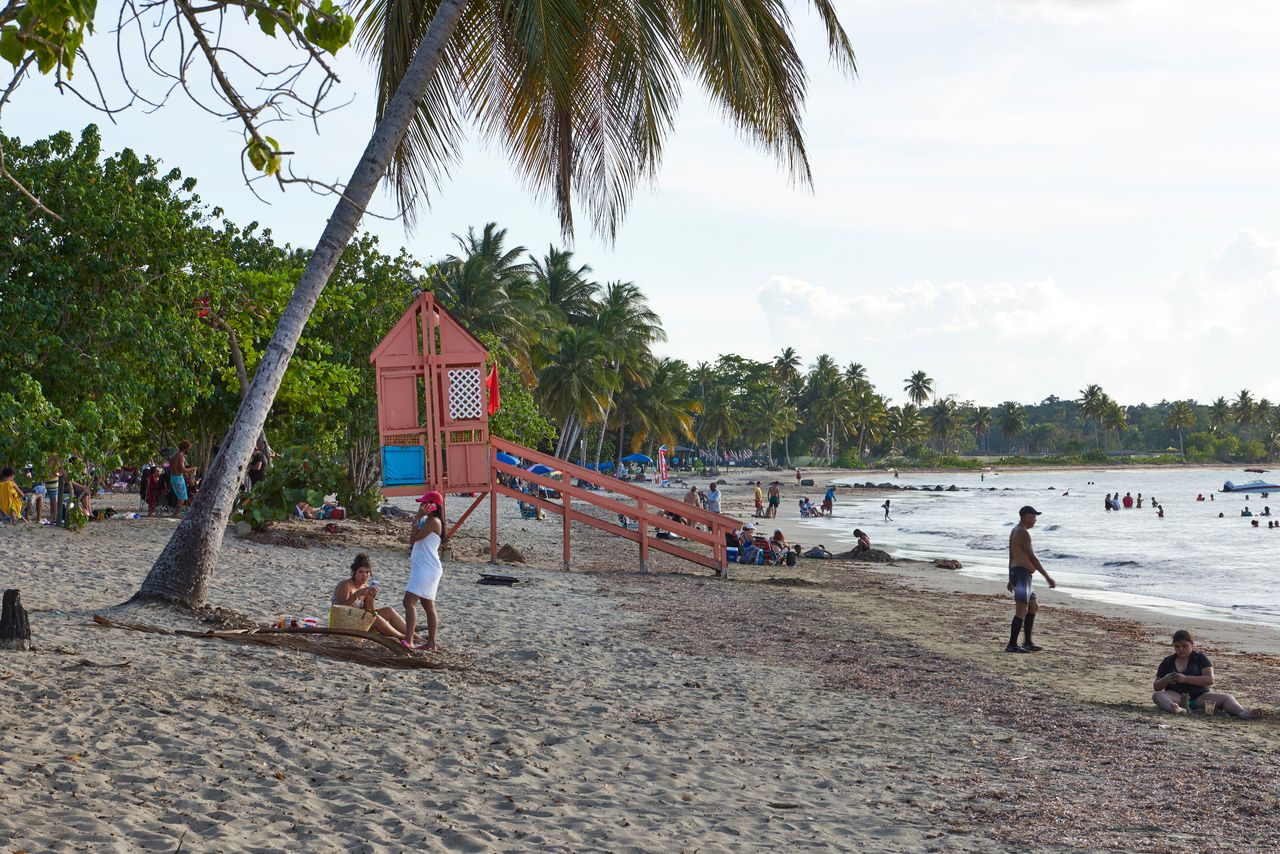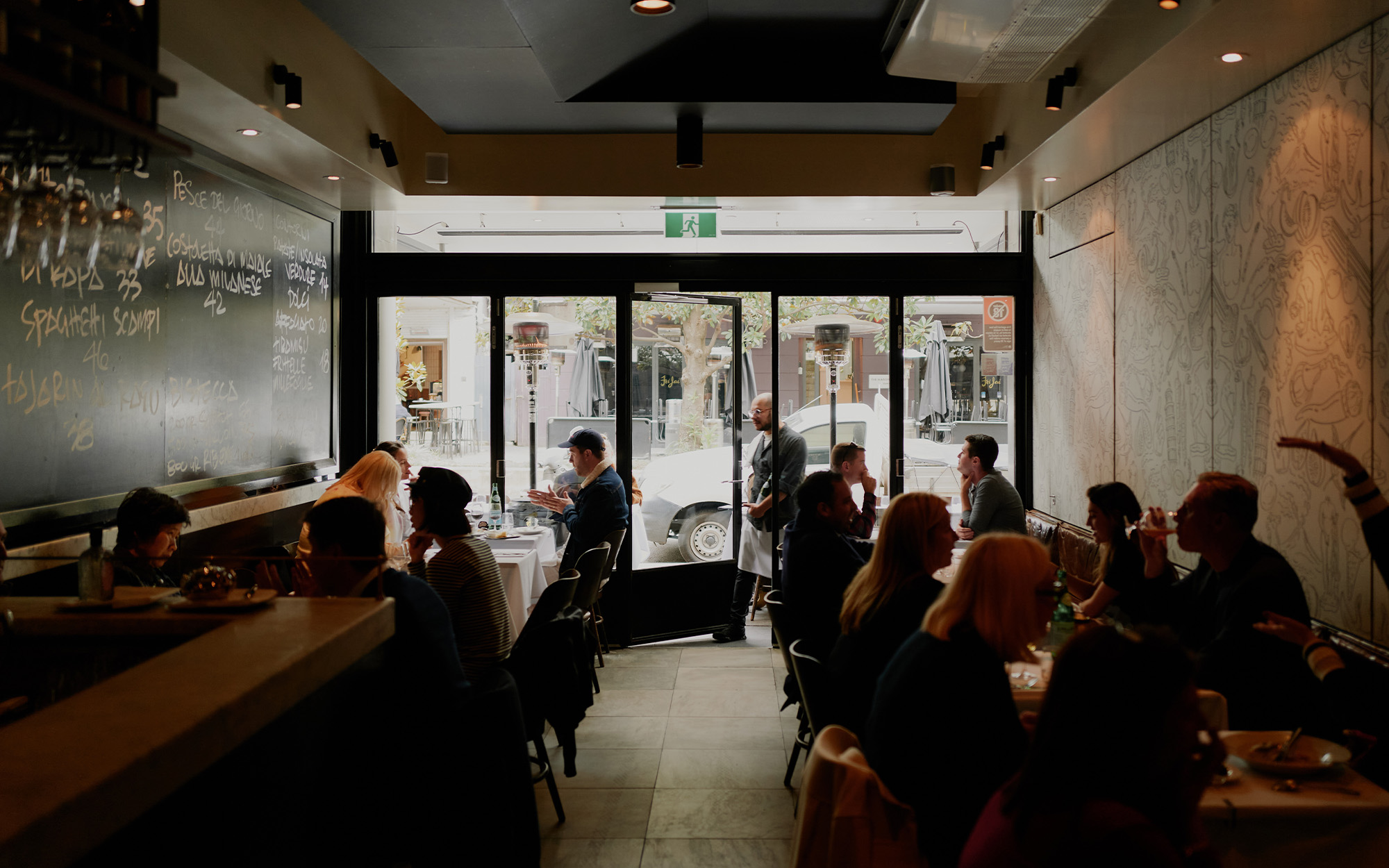Why Wealthy Homebuyers Are Flocking to Puerto Rico
Favourable tax policies, warm weather and a shift to remote work has transformed the island into a full-time destination
In the weeks before real-estate agent Wanda Ithier’s client bought a $40 million house on the Caribbean island of Puerto Rico in March 2022, the sale price was a moving target.
The 13,560-square-foot custom home—located in the Dorado Beach Resort, about 25 miles west of Puerto Rico’s 500-year-old capital city of San Juan—first hit the market for $29.95 million in November 2021, according to Zillow. Amid a market run-up, the price jumped to $34.5 million a few weeks later, and Ithier said it rose higher still during the negotiations that followed. She said her client ultimately agreed to pay $40 million the following March, more than 33% above the original asking price, setting a record for the island.
The deal reflects the fevered pitch of Puerto Rico’s luxury housing market, where favourable tax policies and a Covid era second-home frenzy have opened the floodgates for wealthy home buyers. The buyer of the $40 million home was Wright Wesley Thurston, a crypto entrepreneur, and the seller was investor Jason Moore, records show. “He wanted it,” said Ithier, who represented Thurston with Betty Martinez of Betty Martinez Real Estate. “It was a unique property.” Set on about 1.4 acres, the house has an interior courtyard, an 85-foot-long pool and a 30,000-gallon koi pond, according to marketing materials. Neither Thurston nor Moore responded to requests for comment.
Despite a brief market correction at the end of 2022, Puerto Rico’s luxury housing market is booming, and investors and developers are rushing to capitalise on the desire for high-end homes. Located about 2½ hours southeast of Miami by air, Puerto Rico is known for year-round warm weather and historic areas like Old San Juan, along with beaches, mountains and rainforests. For years, the U.S. territory has also grappled with population decline, a weak economy and infrastructure woes. But wealthy home buyers have been flocking to the island since Covid, boosting sales volume and prices, local real-estate agents said.
In Dorado Beach, a wealthy enclave on the north shore of the island, the median sale price for homes priced above $1 million nearly doubled to $6.2 million in 2022, up from $3.4 million in 2021, according to Sotheby’s International Realty. Prices are also up in other areas, including Condado, an oceanfront neighbourhood of San Juan, Bahia Beach, on the island’s northeast coast, and Palmas del Mar in the southeast.
Local real-estate agents said much of the market surge is rooted in tax incentives, known as Act 60, that are available to individuals and corporations that relocate to Puerto Rico. Individuals who make their primary residence in Puerto Rico by spending at least 183 days a year on the island don’t pay federal income taxes on income sourced in Puerto Rico, according to the tax code. Since 2019, there has also been a requirement that anyone receiving the tax incentives must own a home on the island, which local agents said caused the buyer pool to swell. During Covid, Puerto Rico’s warm climate coupled with the adoption of remote work and Puerto Rico’s low cost of living accelerated the trend of wealthy individuals buying primary and vacation homes on the island.
At the top end of the market, the island’s real-estate growth spurt has played out in a series of mega deals, including Thurston’s $40 million purchase. In December 2022, hedge-funder Glen Scheinberg paid $37 million for a 10,250-square-foot home in the East Beach area of Dorado Beach Resort, two years after the home sold for $18.995 million, according to the local MLS and property records. It couldn’t be determined if Thurston or Scheinberg have been granted the tax-exempt status. Scheinberg declined to comment.
In March 2021, Sean Lonergan, founder and CEO of PruGen Pharmaceuticals, and his wife, Michelle Lonergan, sold a custom-built home in East Beach for $30 million, according to the local MLS. The buyer was Dan Morehead, founder of Pantera Capital, according to records and people familiar with the deal. It couldn’t be determined if Morehead has been granted the tax-exempt status. He and the Lonergans—who did claim the benefit, records show—didn’t respond to requests for comment.
The deals aren’t an anomaly, said Oriana Juvelier of Sotheby’s International Realty, who was involved in the $18.995 million sale in 2020. She said that following Hurricane Maria in 2017, opportunistic investors snapped up distressed properties in Puerto Rico. Momentum in the housing market was building when Covid hit, and the luxury sector “just exploded.”
Tax incentives introduced by Puerto Rico in 2012 were designed to spur economic growth. With a population of approximately 3.2 million as of July 2022, some 40% of Puerto Rico’s residents live in poverty and the median income is just under $22,000, according to the U.S. Census Bureau. Eleven years ago when the incentives were approved, 44.9% of Puerto Rico’s residents lived in poverty, when the median household income was $19,429, census data show.
Under Act 60, the name given to the incentive programs in 2019, eligible businesses pay a 4% corporate tax on services exported from Puerto Rico, said Raul Vidal y Sepulveda, an attorney who advises individuals and companies on tax incentives. Companies with revenue of $3 million or more must employ at least one full-time employee locally, he said. Individuals granted Act 60 benefits don’t pay federal income tax on income sourced in Puerto Rico and they also are exempt from paying Puerto Rico income taxes on interest, dividend income and certain capital gains. To qualify, individuals must live primarily in Puerto Rico, they must own a home there within two years of being granted tax-exempt status, and they must annually donate at least $10,000 to local charity.
After several years of steady growth, the number of individuals granted tax-exempt status under Act 60 jumped from 514 in 2019 to 714 in 2020 and 1,238 in 2021, according to data from Puerto Rico’s Department of Economic Development and Commerce. The number dropped to 721 in 2022, which Vidal y Sepulveda attributes largely to a crash in the crypto market. Cryto entrepreneurs and investors, he said, flocked to the island for Act 60 capital gains benefits when the virtual currency was hitting its peak.
Peter Bazeli, a principal at Weitzman, a residential and hospitality development consulting firm, said Puerto Rico’s tax benefits transformed it from a place people wanted to visit to a destination for wealthy home buyers with the flexibility to move their businesses, including hedge-funders, crypto investors, and other entrepreneurs. He said the movement began in 2012 and was a “slow burn” that skyrocketed in 2020 thanks to Covid and massive wealth generated in the stock market.
“Part of the appeal was you could move to Puerto Rico, save on taxes, have an incredible lifestyle and generally spend less than what you’d spend on a comparable place in Miami or other resort destinations,” he said. “It created this almost club of high-net worth households that have chosen to establish residence in Puerto Rico.”
Crypto investor Michael Terpin was an early mover. He relocated to Puerto Rico from Nevada in 2016 to take advantage of the tax benefits. “I look at this as a 20-year play,” he said. “How much in taxes will I save over 20 years?”

Terpin said since he arrived, a crypto community has formed in Puerto Rico, and he has more friends there than he does in Nevada or Florida, where he also owns homes. In Puerto Rico, he’s fixed up two properties, a condo in San Juan’s Miramar neighbourhood and a house in the Beverly Hills district of Guaynabo, a suburb of San Juan. He said he paid $280,000 for the condo, which is now worth $2.5 million. He paid $700,000 for the house, which is now worth $6 million to $7 million.

Christian Mickelsen, a business coach, author and investor who moved to Puerto Rico from San Diego, Calif., in 2018, didn’t expect to like living on the island as much as he does. He came for the tax benefits, but said he found ample networking and business opportunities along with tropical weather, restaurants, nightlife and water sports. He lives in the Dorado Beach Resort, where he drives around on a golf cart and can order room service.
“Living in California, and paying more than half the money I make in taxes, that was pretty rough,” he said.
Mickelsen also began investing in real estate as the housing market shot up. After buying a five-bedroom home for $3.375 million in 2018, he sold the property for $5 million in 2020. He later purchased two three-bedroom condos in Dorado Beach for $3.6 million and $6.9 million. Both are on the market, for $10.997 million and $15.997 million, respectively, and Mickelsen said he’ll keep whichever doesn’t sell first.
Other aspirational sellers are testing the waters. In February, entrepreneur Christopher Harding listed a 5,600-square-foot house at the Dorado Beach Ritz-Carlton Reserve for $44.95 million. Harding bought the four-bedroom home, with covered patios and an outdoor kitchen, for $10 million in 2020, records show.
Tip Powers, who sold a real-estate company in Virginia and moved full time to Puerto Rico in 2015, has listed a newly-built home in the Dorado Beach Resort for $35.9 million. Powers said he bought the property for $1.6 million in 2018 and demolished an existing home on the site before building a roughly 14,700-square-foot house for himself. Construction took several years and was complete in 2022, by which time Powers said two of his children graduated college and no longer lived at home and two others were halfway done with high school in Puerto Rico. Powers, who lives near Condado, said he plans to stay in Puerto Rico but it no longer makes sense to have a large home in the Dorado area.
Based on other homes on the market, Powers said his home, which has panoramic views of the ocean, is a relative bargain. He also said the appetite for finished homes in Puerto Rico is high. “In this price range, they don’t want a fixer-upper,” he said.
Following a long development drought, Juvelier of Sotheby’s said local builders and some from the mainland U.S. are racing to construct new homes, which are selling at price points Puerto Rico never experienced previously. In San Juan, for example, she estimated there are more than a dozen condominium projects in various stages of development. “The last construction boom here was in the 1970s and 1980s and the real estate reflects that,” she said.
Blanca Hebé López-Pierluisi of Corcoran Puerto Rico said she is marketing several new condos, including the Vanderbilt Residences in San Juan’s Condado neighborhood. The 66-unit oceanfront condominium has 25,000 square feet of amenity space and is being developed by Paulson & Co., hedge-funder John Paulson’s family office.
Prices at the 250-foot tower start at $4 million for residences with city views and $6.2 million for homes with ocean views, López-Pierluisi said, and a roughly 7,380-square-foot oceanfront residence with a nearly 4,200-square-foot terrace is available for $12.5 million. She said the building is over 55% committed without advertising beyond a whisper campaign to friends and family. Closings are set to begin in December 2024.
López-Pierluisi said she is marketing The Icon, also in Condado, a 30-unit boutique condominium with prices ranging from $1.2 million for a two-bedroom to $8 million for a four-bedroom penthouse. The developer is RioBlanco Capital, a Puerto Rico-based private-equity firm.
Local real-estate agents said the priciest homes are still found in the Dorado Beach Resort, a 1,400-acre master-planned community on the north side of the island that was originally developed by Laurance Rockefeller, son of John D. Rockefeller Jr. Laurance Rockefeller was an active conservationist who purchased land throughout the U.S. Virgin Islands. In the 1950s, he bought about 5,000 acres on St. John, and turned it over to the U.S. government to create a national park, according to the National Park Service.
In Puerto Rico, Rockefeller’s resort opened in 1958, according to the resort’s website. The community is anchored by a Ritz-Carlton Reserve hotel that opened in 2012, and it has a clubhouse, multiple golf courses, nature trails, restaurants and Ritz-branded residences.
Sales within the resort jumped from $334 million in 2020 to $568 million in 2021 before falling to $497 million in 2022, said Federico Stubbe, Jr., CEO of PRISA Group, the resort’s co-owner and developer. Despite the 2022 dip, he said PRISA has a robust list of people waiting for new homes in development. PRISA has 29 units for sale out of 169 homes in various stages of construction and development. One project in the pipeline is La Cala, a collection of 14 single-family beachfront homes with prices starting around $30 million. PRISA’s West Point III condominium is a new Ritz-branded building with 10 units, priced between $9 million and $18 million. Stubbe said PRISA launched sales in March and currently has five units under contract.
“I wouldn’t say it’s happened overnight,” said Stubbe, whose family has been developing in Puerto Rico for over 35 years. “The pandemic certainly fast-tracked it a little bit. But this has been a long time coming.”
Still, luxury home-building comes with challenges on an island where construction materials must be imported and labor is in short supply. The island’s electrical system was decimated in Hurricane Maria in 2017 and despite the privatisation of the power grid, there have been persistent outages.
Stubbe said PRISA has invested heavily in infrastructure in and around the resort, including a 107-bed hospital that opened last year as well as backup generators and a water system to compensate for the island’s inconsistent utilities. Luxury homes are generally being built today like bunkers with hurricane-rated windows, generators and cisterns.
Nonetheless, the contrast between the have and have-nots and the influx of wealthy newcomers has fostered resentment among locals, especially those who oppose the tax break, said Nicole Alvarez, an organiser of Abolish Act 60, a grass-roots campaign. Alvarez said the tax break inherently penalises hardworking Puerto Ricans. “While they get infinite tax breaks, we’re handed the shorter end of the stick,” she said, adding that few individuals who relocate to Puerto Rico and claim Act 60 benefits hire local employees.
State Sen. María de Lourdes Santiago Negrón, who proposed legislation in 2021 to repeal the tax incentive for individuals, said the policy has led to gentrification in Puerto Rico. One example is in Puerta de Tierra in San Juan, where investors have purchased about 30 buildings, she said. “It has become an Airbnb corridor,” she said. Santiago Negrón said the benefits of the tax incentive don’t outweigh the negatives. “Some things you just can’t put a price on, like the disappearance of decent housing for Puerto Ricans,” she said.
Mickelsen, the business coach and author, said when he first moved to Puerto Rico, he was worried about locals resenting his presence, but said his fears were unfounded among those he’s met. “Most people are really friendly,” he said.
In recent months, local real-estate agents said the pace of deals has slowed compared with 2022 not only because of economic problems, including interest rates, inflation, stock volatility and lower crypto values, but also because there is a lack of inventory. Meanwhile, agents say the appetite for luxury homes is still strong.
“We’re catching up to demand,” said Stubbe, who said there has been no slowdown with regard to new home sales.
López-Pierluisi of Corcoran said the spring market is stronger than she anticipated, likely because many people who moved to Puerto Rico to take advantage of the tax incentives are coming up on the deadline to purchase real estate.
Despite fluctuations in the market for properties between $2 million to $8 million, there is scant inventory for ultraluxury homes, said real-estate agent Karla Barrera-Morstad of Island&Key, the listing agent for the $40 million home last year. “There’s still a scarcity of big turn-key new construction homes,” she said. “When you start talking about homes with over 10,000 square feet or an ocean view, there’s really not much.”
 Copyright 2020, Dow Jones & Company, Inc. All Rights Reserved Worldwide. LEARN MORE
Copyright 2020, Dow Jones & Company, Inc. All Rights Reserved Worldwide. LEARN MORE
This stylish family home combines a classic palette and finishes with a flexible floorplan
Just 55 minutes from Sydney, make this your creative getaway located in the majestic Hawkesbury region.
Ahead of the Games, a breakdown of the city’s most desirable places to live
PARIS —Paris has long been a byword for luxurious living. The traditional components of the upscale home, from parquet floors to elaborate moldings, have their origins here. Yet settling down in just the right address in this low-rise, high-density city may be the greatest luxury of all.
Tradition reigns supreme in Paris real estate, where certain conditions seem set in stone—the western half of the city, on either side of the Seine, has long been more expensive than the east. But in the fashion world’s capital, parts of the housing market are also subject to shifting fads. In the trendy, hilly northeast, a roving cool factor can send prices in this year’s hip neighborhood rising, while last year’s might seem like a sudden bargain.
This week, with the opening of the Olympic Games and the eyes of the world turned toward Paris, The Wall Street Journal looks at the most expensive and desirable areas in the City of Light.
The Most Expensive Arrondissement: the 6th
Known for historic architecture, elegant apartment houses and bohemian street cred, the 6th Arrondissement is Paris’s answer to Manhattan’s West Village. Like its New York counterpart, the 6th’s starving-artist days are long behind it. But the charm that first wooed notable residents like Gertrude Stein and Jean-Paul Sartre is still largely intact, attracting high-minded tourists and deep-pocketed homeowners who can afford its once-edgy, now serene atmosphere.
Le Breton George V Notaires, a Paris notary with an international clientele, says the 6th consistently holds the title of most expensive arrondissement among Paris’s 20 administrative districts, and 2023 was no exception. Last year, average home prices reached $1,428 a square foot—almost 30% higher than the Paris average of $1,100 a square foot.
According to Meilleurs Agents, the Paris real estate appraisal company, the 6th is also home to three of the city’s five most expensive streets. Rue de Furstemberg, a secluded loop between Boulevard Saint-Germain and the Seine, comes in on top, with average prices of $2,454 a square foot as of March 2024.
For more than two decades, Kyle Branum, a 51-year-old attorney, and Kimberly Branum, a 60-year-old retired CEO, have been regular visitors to Paris, opting for apartment rentals and ultimately an ownership interest in an apartment in the city’s 7th Arrondissement, a sedate Left Bank district known for its discreet atmosphere and plutocratic residents.
“The 7th was the only place we stayed,” says Kimberly, “but we spent most of our time in the 6th.”
In 2022, inspired by the strength of the dollar, the Branums decided to fulfil a longstanding dream of buying in Paris. Working with Paris Property Group, they opted for a 1,465-square-foot, three-bedroom in a building dating to the 17th century on a side street in the 6th Arrondissement. They paid $2.7 million for the unit and then spent just over $1 million on the renovation, working with Franco-American visual artist Monte Laster, who also does interiors.
The couple, who live in Santa Barbara, Calif., plan to spend about three months a year in Paris, hosting children and grandchildren, and cooking after forays to local food markets. Their new kitchen, which includes a French stove from luxury appliance brand Lacanche, is Kimberly’s favourite room, she says.
Another American, investor Ashley Maddox, 49, is also considering relocating.
In 2012, the longtime Paris resident bought a dingy, overstuffed 1,765-square-foot apartment in the 6th and started from scratch. She paid $2.5 million and undertook a gut renovation and building improvements for about $800,000. A centrepiece of the home now is the one-time salon, which was turned into an open-plan kitchen and dining area where Maddox and her three children tend to hang out, American-style. Just outside her door are some of the city’s best-known bakeries and cheesemongers, and she is a short walk from the Jardin du Luxembourg, the Left Bank’s premier green space.
“A lot of the majesty of the city is accessible from here,” she says. “It’s so central, it’s bananas.” Now that two of her children are going away to school, she has listed the four-bedroom apartment with Varenne for $5 million.
The Most Expensive Neighbourhoods: Notre-Dame and Invalides
Garrow Kedigian is moving up in the world of Parisian real estate by heading south of the Seine.
During the pandemic, the Canada-born, New York-based interior designer reassessed his life, he says, and decided “I’m not going to wait any longer to have a pied-à-terre in Paris.”
He originally selected a 1,130-square-foot one-bedroom in the trendy 9th Arrondissement, an up-and-coming Right Bank district just below Montmartre. But he soon realised it was too small for his extended stays, not to mention hosting guests from out of town.
After paying about $1.6 million in 2022 and then investing about $55,000 in new decor, he put the unit up for sale in early 2024 and went house-shopping a second time. He ended up in the Invalides quarter of the 7th Arrondissement in the shadow of one Paris’s signature monuments, the golden-domed Hôtel des Invalides, which dates to the 17th century and is fronted by a grand esplanade.
His new neighbourhood vies for Paris’s most expensive with the Notre-Dame quarter in the 4th Arrondissement, centred on a few islands in the Seine behind its namesake cathedral. According to Le Breton, home prices in the Notre-Dame neighbourhood were $1,818 a square foot in 2023, followed by $1,568 a square foot in Invalides.
After breaking even on his Right Bank one-bedroom, Kedigian paid $2.4 million for his new 1,450-square-foot two-bedroom in a late 19th-century building. It has southern exposures, rounded living-room windows and “gorgeous floors,” he says. Kedigian, who bought the new flat through Junot Fine Properties/Knight Frank, plans to spend up to $435,000 on a renovation that will involve restoring the original 12-foot ceiling height in many of the rooms, as well as rescuing the ceilings’ elaborate stucco detailing. He expects to finish in 2025.
Over in the Notre-Dame neighbourhood, Belles demeures de France/Christie’s recently sold a 2,370-square-foot, four-bedroom home for close to the asking price of about $8.6 million, or about $3,630 a square foot. Listing agent Marie-Hélène Lundgreen says this places the unit near the very top of Paris luxury real estate, where prime homes typically sell between $2,530 and $4,040 a square foot.
The Most Expensive Suburb: Neuilly-sur-Seine
The Boulevard Périphérique, the 22-mile ring road that surrounds Paris and its 20 arrondissements, was once a line in the sand for Parisians, who regarded the French capital’s numerous suburbs as something to drive through on their way to and from vacation. The past few decades have seen waves of gentrification beyond the city’s borders, upgrading humble or industrial districts to the north and east into prime residential areas. And it has turned Neuilly-sur-Seine, just northwest of the city, into a luxury compound of first resort.
In 2023, Neuilly’s average home price of $1,092 a square foot made the leafy, stately community Paris’s most expensive suburb.
Longtime residents, Alain and Michèle Bigio, decided this year is the right time to list their 7,730-square-foot, four-bedroom townhouse on a gated Neuilly street.
The couple, now in their mid 70s, completed the home in 1990, two years after they purchased a small parcel of garden from the owners next door for an undisclosed amount. Having relocated from a white-marble château outside Paris, the couple echoed their previous home by using white- and cream-coloured stone in the new four-story build. The Bigios, who will relocate just back over the border in the 16th Arrondissement, have listed the property with Emile Garcin Propriétés for $14.7 million.
The couple raised two adult children here and undertook upgrades in their empty-nester years—most recently, an indoor pool in the basement and a new elevator.
The cool, pale interiors give way to dark and sardonic images in the former staff’s quarters in the basement where Alain works on his hobby—surreal and satirical paintings, whose risqué content means that his wife prefers they stay downstairs. “I’m not a painter,” he says. “But I paint.”
The Trendiest Arrondissement: the 9th
French interior designer Julie Hamon is theatre royalty. Her grandfather was playwright Jean Anouilh, a giant of 20th-century French literature, and her sister is actress Gwendoline Hamon. The 52-year-old, who divides her time between Paris and the U.K., still remembers when the city’s 9th Arrondissement, where she and her husband bought their 1,885-square-foot duplex in 2017, was a place to have fun rather than put down roots. Now, the 9th is the place to do both.
The 9th, a largely 19th-century district, is Paris at its most urban. But what it lacks in parks and other green spaces, it makes up with nightlife and a bustling street life. Among Paris’s gentrifying districts, which have been transformed since 2000 from near-slums to the brink of luxury, the 9th has emerged as the clear winner. According to Le Breton, average 2023 home prices here were $1,062 a square foot, while its nearest competitors for the cool crown, the 10th and the 11th, have yet to break $1,011 a square foot.
A co-principal in the Bobo Design Studio, Hamon—whose gut renovation includes a dramatic skylight, a home cinema and air conditioning—still seems surprised at how far her arrondissement has come. “The 9th used to be well known for all the theatres, nightclubs and strip clubs,” she says. “But it was never a place where you wanted to live—now it’s the place to be.”
With their youngest child about to go to college, she and her husband, 52-year-old entrepreneur Guillaume Clignet, decided to list their Paris home for $3.45 million and live in London full-time. Propriétés Parisiennes/Sotheby’s is handling the listing, which has just gone into contract after about six months on the market.
The 9th’s music venues were a draw for 44-year-old American musician and piano dealer, Ronen Segev, who divides his time between Miami and a 1,725-square-foot, two-bedroom in the lower reaches of the arrondissement. Aided by Paris Property Group, Segev purchased the apartment at auction during the pandemic, sight unseen, for $1.69 million. He spent $270,000 on a renovation, knocking down a wall to make a larger salon suitable for home concerts.
During the Olympics, Segev is renting out the space for about $22,850 a week to attendees of the Games. Otherwise, he prefers longer-term sublets to visiting musicians for $32,700 a month.
Most Exclusive Address: Avenue Junot
Hidden in the hilly expanses of the 18th Arrondissement lies a legendary street that, for those in the know, is the city’s most exclusive address. Avenue Junot, a bucolic tree-lined lane, is a fairy-tale version of the city, separate from the gritty bustle that surrounds it.
Homes here rarely come up for sale, and, when they do, they tend to be off-market, or sold before they can be listed. Martine Kuperfis—whose Paris-based Junot Group real-estate company is named for the street—says the most expensive units here are penthouses with views over the whole of the city.
In 2021, her agency sold a 3,230-square-foot triplex apartment, with a 1,400-square-foot terrace, for $8.5 million. At about $2,630 a square foot, that is three times the current average price in the whole of the 18th.
Among its current Junot listings is a 1930s 1,220-square-foot townhouse on the avenue’s cobblestone extension, with an asking price of $2.8 million.
This stylish family home combines a classic palette and finishes with a flexible floorplan
Just 55 minutes from Sydney, make this your creative getaway located in the majestic Hawkesbury region.





















